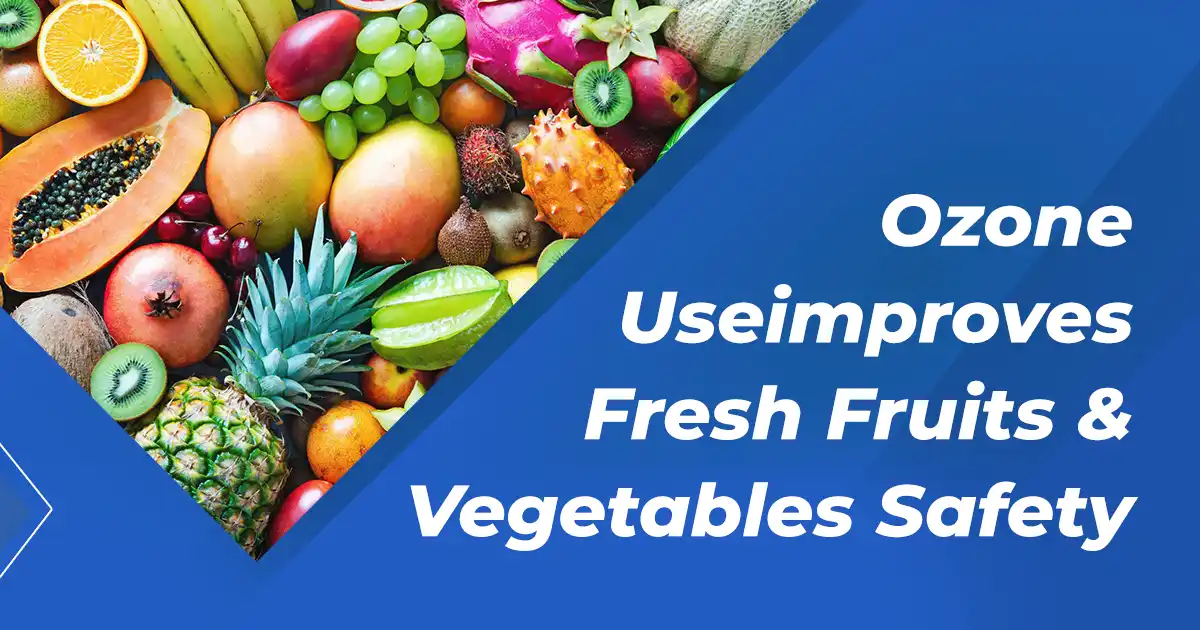Ozone Useimproves Fresh Fruits & Vegetables Safety

Today ,Fresh fruits and vegetables are being washed with traditional sanitizerssuch as chlorine for years now. Chlorine has its limitations as far as the log reduction of bacteria it can achieve. Moreover the use of chlorine results in the formation of toxic by products such as THMs that are deposited on the surface of the fruits and vegetable and if consumed raw , can find their way into the human system. Alternate sanitisers, especially Ozone has now been validated as the most useful among all know sanitizers in the world. Apart ozone provides other benefits too
How did ozone find its place in food processing Industry ?
Food borne illness due to food pathogens started increasing when chlorine has been the major sanitizer to be used. Fruit spoilage percentages did not come down even with use of large doses of chlorine, indicating that it has limited role in preventing fruit spoilage. Chlorine is just not effective against surface moulds and yeast that is responsible for food spoilage and against production of ethelene that enhances fruit ripening during storage . It was also notices that pesticides that are used during fruits and vegetable growing are not effectively removed with best of washing with chlorinated water . Pesticide residues still remain in fruit surfaces .
Large amounts of water is used in the fruit and vegetable industries. It also genaerates large amounts of waste water with very high concentrations of BOD, that has been linked to cancer, death of marine species, water pollution and eco system damage . In today’s strict environmental standards treating such waste waters have proven to be very expensive
With the advent of ozone, the food processing industries have an alternate sanitizing agent that can solve many of the present problems faced by industries while using chlorinated water
Benefits of OZONE in Food Processing industry
- Most eco friendly sanitizer. Does not from toxic compounds such as TMMs
- Ozone is 1.5 times stronger than chlorine and is effective over a much wider spectrum of microorganisms than chlorine and other disinfectants. Ozone kills bacteria such as Escherichia coli, Listeria, and other food pathogens much faster than traditionally used disinfectants.
- Ozone effectively removes pesticides residue on the surfaces of the fruits and vegetable and enhances its safety
- Ozone is very effective against mould and yeasts and reduces spoilage. Infact in the US , after they have a started adopting ozone as a sanitizer, the food spoilage has been reduced from 30% to 5 % at present
- Ozone prevents ethylene production ( causes ripening of fruits ) and hence delays ripening to make transportation more effective
- With the use of ozone, the water water contains less of COD.BOD and AOX and it is easier to treat the waste water and confirm to pollution control standards . Waste water Treatment costs are reduced
- Since the food industry uses plenty of water, reuse of the water is often looked at . Using ozone as a sanitizer ensures that reuse of the waste water is easily achievable
- Using high concentrations of chlorine will impart chlorine smell to the fruits that consumers detest . Ozone prevents this unfavorable odur and flavor on the fruits and vegetables. The higher the chlorine concentrations, the more likely that THMs are formed making the fruits and vegetable unsafe. Many countries including JAPAN forbids the presence of THMS on the fruit surfaces
Ozone is produced by corona discharge method and introduced into the treated water to achieve an ozone residual of 0.5 to 1.0 ppm . This water is than used to wash the fruits and vegetable. To achieve this 0.5 to 1.0 ppm ozone in the water, accepted ozone introduction methods must be used. Just introducing the ozone into the water though nozzles or pipes without any mixing devices and contact time can never be effective. Domestic ozone washers are not effective to achieve this residual ozone levels in the water and hence their performances are questionable


